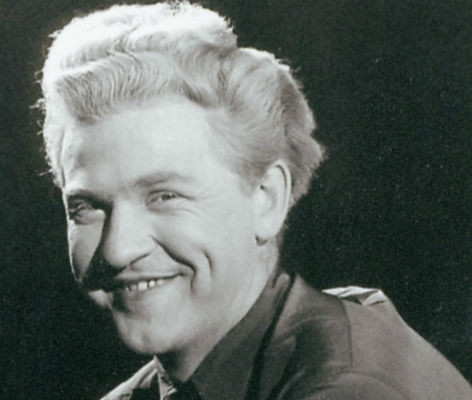
Volfgangs Dārziņš
(25.11.1906 - 24.06.1962 )
“He who wants to, is able to do more than he can.”
Volfgangs Dārziņš was born in Riga on November 25, 1906, the son of composer Emīls Dārziņš. In addition to composing, he performed regularly as a
pianist, worked as a music critic and writer, taught music and was also interested in ethnomusicology. He graduated from the Latvian Conservatory, where he studied composition theory under Jāzeps Vītols (1924–1929) and piano under Bonifācija Roge and Nadežda Kārkliņa (1929–1934).
Dārziņš won five out of eight possible awards in the new choral compositions competition at the 8 th General Latvian Song Festival, for four arrangements of folk songs and his original composition “Birzēm rotāts” (Adorned by Birch Groves). Already as a student, he began writing about music for the Latvis newspaper and the Burtnieks, Mūzikas Apskats and Latvju Mēnešraksts periodicals. In 1934 he became the editor of the music section at the Rīts newspaper, and during the war he published articles in Tēvija. Dārziņš later also wrote for Latvian exile publications in Germany and the United States.
Having fled from Latvia as a refugee at the end of the Second World War, Dārziņš arrived in Berlin, then Ehingen on the banks of the Danube River, and eventually settled in Esslingen after the end of the war. He emigrated to the United States in 1950 and settled in Spokane, Washington, where he began teaching at the local conservatory and also played the organ and conducted the choir in the local Lutheran church. However, he soon abandoned those activities to focus on performing as a pianist. He did six large concert tours as a pianist between 1952 and 1956 for a total of about one hundred concerts, not counting smaller solo concerts. He performed Chopin, Beethoven, Scarlatti, Mozart, Schumann, Debussy and sometimes also his own compositions. According to musicologist Arnolds Klotiņš, “Dārziņš’ performance is characterised by great spiritual tension and the quelling of the sensual, sentimental side of music in favour of logically constructive expression and clarity.”
Dārziņš moved to Seattle in 1955, where he taught piano to graduates of the Music Department of the University of Washington (Seattle). During this period he performed only upon special invitation and generally only for audiences of music connoisseurs; he also served as a juror for a variety of American music competitions. He turned his attention to studying Latvian folk songs, as evidenced by his in-depth article “Latvju tautas melodiju veidi un īpatnības” (Types and Peculiarities of Latvian Folk Melodies, published in Vol. 11 of the 1956 “Copenhagen/Imanta” collection of Latvian dainas), which includes examples of 120 melodies and eight maps, as well as the many lectures he gave on the subject in the mid-1950s. Dārziņš’ compositions for piano and his arrangements of folk songs also reflect a strong influence from folk music, not in the form of quotations or allusions but at a much deeper level. Klotiņš again: “Apparently his goal was to intercept and recreate the tonal, and especially the metro-rhythmic and constructive, elements of Latvian folklore as well as in some cases the reconstruction of the archaic aesthetics of folk music.”
Dārziņš’ post-war compositions were gradually published by Alfrēds Kalnājs’ publishing house in Chicago, and the composer himself participated in the typesetting process. All of his main compositions were published by 1962, and the most important of these were included the Dow Publishers, Inc. (New York) catalogue of new music in 1960. Dārziņš received the American Latvian Association’s Cultural Foundation Award in 1953 as well as its honorary award in 1962. After his death on June 24, 1962, the University of Washington established the Volfgangs Dārziņš Commemorative Foundation and organised several large commemorative concerts. Dārziņš was reinterred in the Mārtiņš Cemetery in Riga next to his father in 1999.
Dārziņš’ contribution to Latvian music is still not fully comprehended and appreciated. He is one of those rare composers who sought and found his own independent style in contrast to the tradition of romanticism founded by Jāzeps Vītols, in which the work of most post-war Latvian composers was rooted. Klotiņš has commented: “Whether consciously or not, in the post-war years Dārziņš took on a mission in the modern development of Latvian music that no other composer had previously undertaken nor, it seems, has done so since, at least in the genre of instrumental music. Namely, he took a step that has been taken by the musical cultures of certain other European nations, the benchmark of which was set by Béla Bartók in Hungary. This was a step away from using a relatively new, late folk lyricism towards the reinterpretation and development in an instrumental style of the formative, constructive and colouristic possibilities of an older stratum of folk music. In this respect, Dārziņš, like Bartók, also bid farewell to romanticism and moved towards neoclassical structures. These qualities, as well as the shift in emphasis from the vocal music so traditional to Latvians to the genre of instrumental music, made
Dārziņš’ musical legacy something thoroughly new and still not fully comprehended in the otherwise generally vocalised and emotionalised landscape of our music.”
